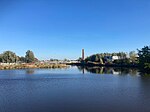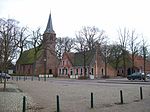Lettelbert

Lettelbert (Dutch pronunciation: [ˈlɛ.təlˌbɛrt]; Gronings: Lepterd) is a village in the municipality of Westerkwartier in the province of Groningen in the Netherlands. As of 2021, it had a population of 150. Agriculture and livestock are the main sources of income. Lettelbert means 'small neighborhood' (kleine buurt), near Lettelbert are also 'old neighborhood' (oude buurt) and 'new neighborhood' (nieuwe buurt), namely the villages of Tolbert and Niebert. The village arose in the Middle Ages on a sand ridge in the Westerkwartier near the Lettelberterdiep. The Reformed church of Lettelbert is owned by the Stichting Oude Groninger Kerken. The single-aisled church was built in the thirteenth century and has a five-sided closed choir and a roof turret. Lettelbert has a small marina on the Leekstermeer and a natural camping site. Near the village are the Lettelberterpetten, a peat area that was extracted between 1900 and 1920 and became overgrown with alder woods and has been a nature reserve of Het Groninger Landschap since 1961.
Excerpt from the Wikipedia article Lettelbert (License: CC BY-SA 3.0, Authors, Images).Lettelbert
Hoofdstraat, Westerkwartier
Geographical coordinates (GPS) Address Nearby Places Show on map
Geographical coordinates (GPS)
| Latitude | Longitude |
|---|---|
| N 53.183333333333 ° | E 6.4 ° |
Address
Hoofdstraat 156a
9355 TE Westerkwartier
Groningen, Netherlands
Open on Google Maps











